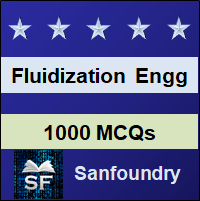
Fluidization Engineering Multiple Choice Questions Highlights
- 1000+ Multiple Choice Questions & Answers (MCQs) in Fluidization Engineering with a detailed explanation of every question.- These MCQs cover theoretical concepts, true-false(T/F) statements, fill-in-the-blanks and match the following style statements.
- These MCQs also cover numericals as well as diagram oriented MCQs.
- These MCQs are organized chapterwise and each Chapter is futher organized topicwise.
- Every MCQ set focuses on a specific topic of a given Chapter in Fluidization Engineering Subject.
Who should Practice Fluidization Engineering MCQs?
– Students who are preparing for college tests and exams such as mid-term tests and semester tests on Fluidization Engineering.- Students who are preparing for Online/Offline Tests/Contests in Fluidization Engineering.
– Students who wish to sharpen their knowledge of Fluidization Engineering Subject.
- Anyone preparing for Aptitude test in Fluidization Engineering.
- Anyone preparing for interviews (campus/off-campus interviews, walk-in interview and company interviews).
- Anyone preparing for entrance examinations and other competitive examinations.
- All - Experienced, Freshers and College / School Students.
Fluidization Engineering Chapters
Here's the list of chapters on the "Fluidization Engineering" subject covering 100+ topics. You can practice the MCQs chapter by chapter starting from the 1st chapter or you can jump to any chapter of your choice.- Introduction
- Particles and Fluidization
- Industrial Applications of Fluidized Beds
- Fluidization and Mapping of Regimes
- Bubbles in Dense Bed
- Two – Phase Theory of Fluidization
- Solids Movement, Mixing, Segregation and Staging
- Transport Effects in Fluidized Systems
- Fluidized Bed Heat Transfer
- Circulation Systems
- Design of Fluidized Bed Systems
1. Introduction
The section contains multiple choice questions and answers on fluidization operations types, heat exchanger, transportation and mixing of fine powder.
|
|
|
2. Particles and Fluidization
The section contains questions and answers on plastic materials coating, particle growth, drying and sizing, adsorption and synthesis reactions.
|
|
|
3. Industrial Applications of Fluidized Beds
The section contains MCQs on industrial applications of fluidized bed, fluid catalytic cracking and reforming, fluid coking, thermal cracking, charcoal activation, limestone calcination, dolomite, carbonization of coal and coke, cement clinker, roasting of sulphide ores and iron oxides reduction.
4. Fluidization and Mapping of Regimes
The section contains multiple choice questions and answers on size of particles, minimum fluidizing velocity, terminal velocity of particles, pressure drops in fluidized beds, distributor, voidage, viscosity and fluidity of fluidized bed, transport disengaging height and size distributions.
|
|
|
5. Bubbles in Dense Bed
The section contains questions and answers on power consumption, single rising bubble, ordinary bubbling beds, individual particles movement and rate of solids.
|
|
|
6. Two – Phase Theory of Fluidization
The section contains MCQs on time distribution of solids, diffusion model, bubbles causing, emulsion phase, interpretation of solid mixing data.
|
|
|
7. Solids Movement, Mixing, Segregation and Staging
The section contains multiple choice questions and answers on axial and lateral dispersion of solids, diffusion models for gas flow, gas effects by solids, ideal mixing stage model, two region models, bubbling bed model, axial and radial dispersion of gas.
|
|
|
8. Transport Effects in Fluidized Systems
The section contains questions and answers on time distribution of gas, heat transfer rate and catalytic conversion from bubbling bed model, conversions of emulsion gas, contacting efficiency and successive reaction applications.
|
|
|
9. Fluidized Bed Heat Transfer
The section contains MCQs on controlling of bubble size, heat transfer rate, heat transfer to immersed tubes and objects, containing vessel and bed wall heat transfer theories.
|
|
|
10. Circulation Systems
The section contains multiple choice questions and answers on tdh single size and size distribution of solids, elutriation, circulation rate for deactivating catalyst and heat removal rate, pressure drop in stick-slip and aerated flow, horizantal and vertical pipes, minimum gas velocity for horizantal and vertical flows, pressure drop in pneumatic conveyors and bends.
|
|
|
11. Design of Fluidized Bed Systems
The section contains questions and answers on physical operations, batch operations, continuous operations, hot gases quencing, bench scale and pilot plant reactors, deactivating catalyst, regenerator and reactor regenerator system, design of noncatalytic gas reactors, kinetic models, noncatalytic gas phase reactions, conversion of solids and gases.
|
|
|
Wish you the best in your endeavor to learn and master Fluidization Engineering!
